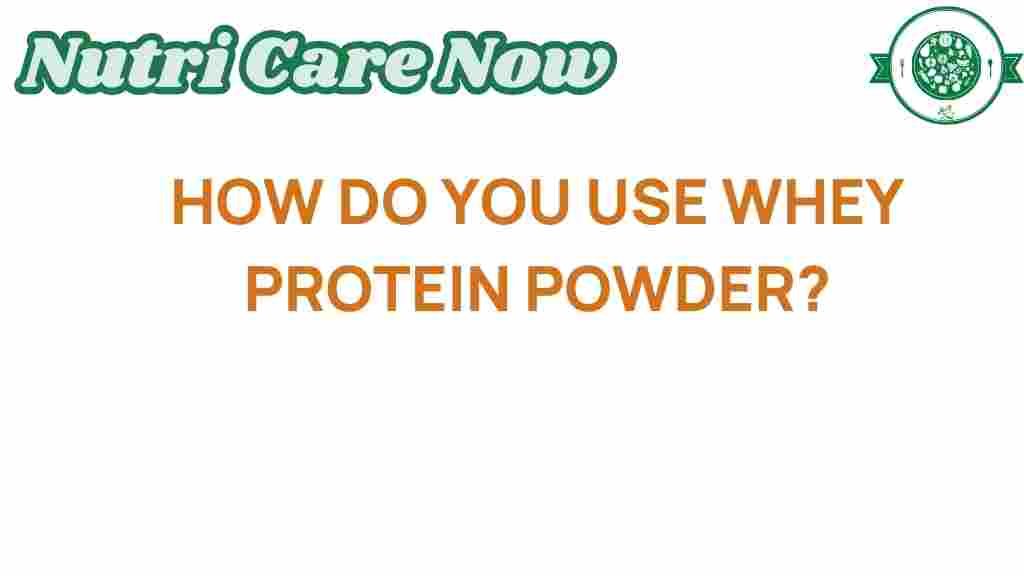Unveiling the Secrets: How to Effectively Use Whey Protein
Whey protein has become a staple in the diets of fitness enthusiasts, athletes, and health-conscious individuals alike. With its powerful nutritional benefits, whey protein is a versatile supplementation option that can help you achieve your health and fitness goals. This article will guide you through the effective use of whey protein powder, explore its benefits for muscle gain, post-workout recovery, and provide delicious recipes to incorporate it into your diet.
The Nutritional Benefits of Whey Protein
Whey protein is a high-quality protein derived from milk during the cheese-making process. It contains all nine essential amino acids, making it a complete protein source. Here are some key nutritional benefits of whey protein:
- High Biological Value: Whey protein has a high biological value (BV), which means it is easily absorbed and utilized by the body.
- Supports Muscle Gain: The amino acids in whey protein are crucial for muscle repair and growth, making it ideal for those looking to increase muscle mass.
- Boosts Immunity: Whey protein contains immunoglobulins and lactoferrin, which can help enhance the immune system.
- Weight Management: Incorporating whey protein into your diet can help you feel fuller for longer, aiding in weight loss and management.
How to Incorporate Whey Protein into Your Diet
Using whey protein effectively requires a strategic approach to supplementation and diet. Below are several steps to help you seamlessly integrate whey protein into your nutrition plan.
1. Choose the Right Whey Protein
There are several types of whey protein available on the market, including:
- Whey Protein Concentrate: Contains about 70-80% protein and retains some fat and carbohydrates. It’s a great option for those seeking a more natural product.
- Whey Protein Isolate: Contains about 90% protein and is processed to remove most fat and lactose. Ideal for those who are lactose intolerant or looking for a low-carb option.
- Whey Protein Hydrolysate: Predigested for faster absorption, making it perfect for post-workout recovery.
2. Determine Your Protein Needs
Your protein requirements may vary based on your activity level, goals, and body weight. As a general guideline:
- For muscle gain: Aim for 1.6 to 2.2 grams of protein per kilogram of body weight.
- For general health: 0.8 grams per kilogram of body weight is sufficient.
Calculate your needs to determine how much whey protein you should incorporate into your daily diet.
3. Timing Your Whey Protein Intake
The timing of whey protein supplementation can enhance its benefits. Here are some recommended times to take whey protein:
- Post-Workout: Consuming whey protein within 30 minutes of your workout can help optimize muscle recovery and growth.
- Morning Boost: Adding whey protein to your breakfast can kickstart your metabolism and provide a protein-rich start to your day.
- Between Meals: Use whey protein as a snack between meals to help meet your protein requirements and curb hunger.
4. Create Delicious Whey Protein Recipes
Whey protein doesn’t have to be consumed only in shakes. Here are some creative recipes to incorporate whey protein into your meals:
Protein-Packed Smoothie
Blend together:
- 1 scoop of whey protein
- 1 cup of spinach
- 1 banana
- 1 cup of almond milk
- 1 tablespoon of nut butter
This smoothie is not only delicious but also packed with nutrients to fuel your day.
Whey Protein Pancakes
Mix the following ingredients to make a nutritious breakfast:
- 1 cup of oats
- 1 scoop of whey protein
- 1 banana
- 2 eggs
- 1/2 cup of milk
Cook on a skillet for a protein-rich breakfast that will keep you energized.
Troubleshooting Common Whey Protein Issues
While whey protein is generally well-tolerated, some individuals may experience issues. Here are some common problems and solutions:
Digestive Discomfort
If you experience bloating or discomfort after consuming whey protein, consider:
- Switching to whey protein isolate, which contains less lactose.
- Gradually increasing your protein intake to allow your digestive system to adapt.
Not Seeing Results
If you aren’t seeing the expected muscle gain or weight loss, evaluate the following:
- Ensure you are consuming enough total protein throughout the day.
- Check your workout routine and ensure you’re challenging your muscles adequately.
- Monitor your overall caloric intake to align with your goals.
Conclusion
Whey protein is a powerful tool in your nutrition arsenal for enhancing fitness, supporting muscle gain, and promoting overall health. By choosing the right type of whey protein, timing your intake, and incorporating it into delicious recipes, you can make the most out of this supplementation. Remember to listen to your body and adjust your intake as needed. For more information on nutrition and supplementation, check out this comprehensive guide. Start your journey toward improved health and fitness today!
With the right approach, whey protein can help you reach your fitness goals while enjoying a variety of tasty meals and snacks.
This article is in the category Supplements and created by NutriCareNow Team
